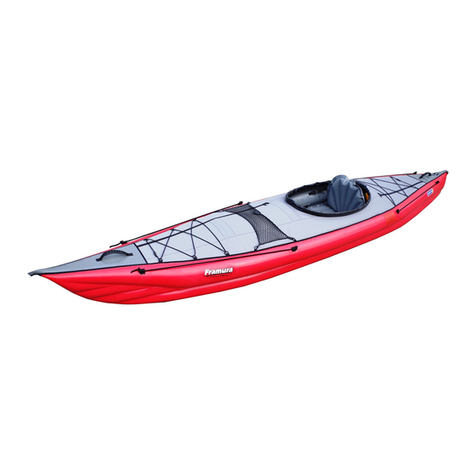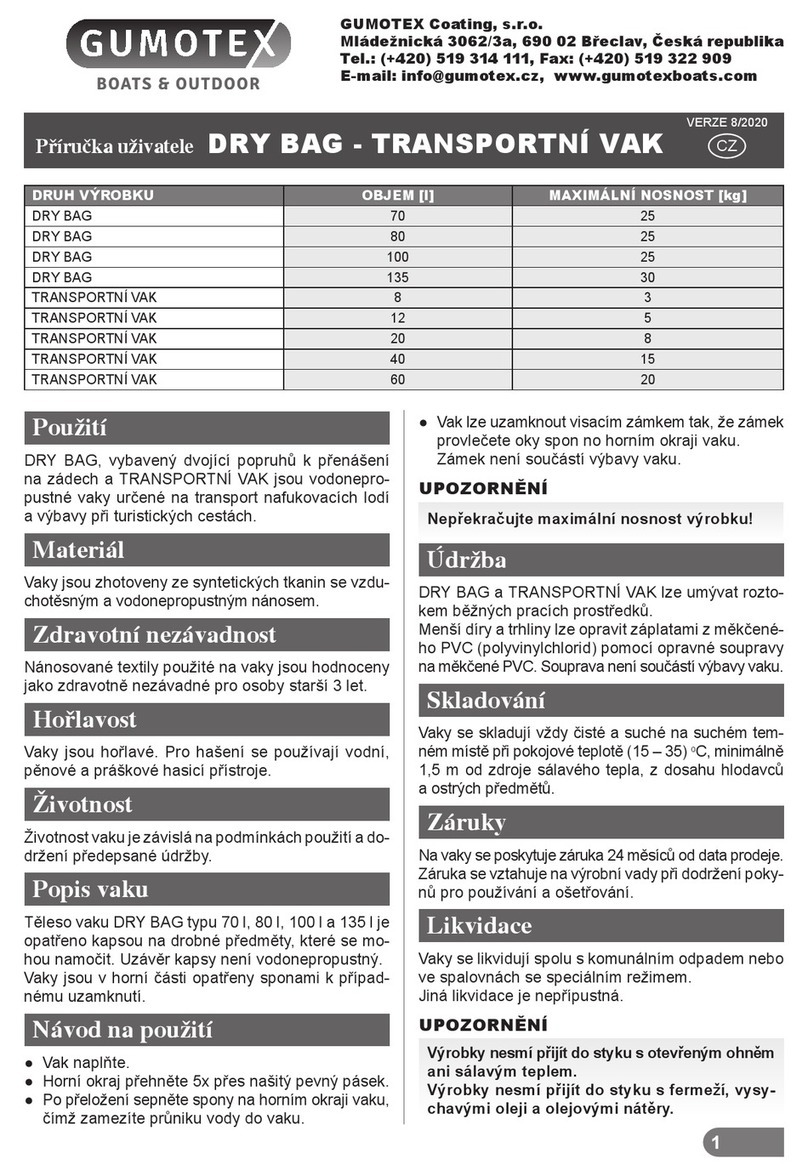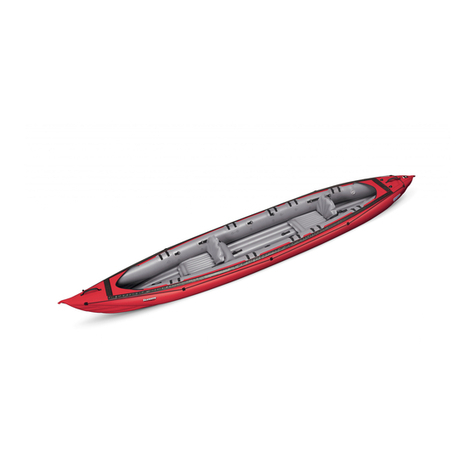
9
4
3
15
Befestigung des Steuers am Boot
Vor dem ersten Einsatz des Steuers ist es nötig, auf den
hinteren Bord das Band mit Kletterverschluss (10) aufzu-
kleben, siehe Abb. Nr. 3. Um eine perfekte Verbindung
herzustellen, muss die zu klebende Oberfl äche trocken,
sauber und mit Azeton entfettet werden.
Unter den hinteren Bord des Bootes legen Sie die
Basis (11) ein und ziehen Sie den Sechskant durch das
Ausgussloch durch. Von der Außenseite legen Sie die
Konsole (11), die Scheibe (12) an und ziehen Sie diese
mittels der Feststellschraube (13) nach. Ziehen Sie aus
dem Bolzen des Steuers den Sicherungsring (14) heraus.
Legen Sie den Bolzen in die Bohrung ein und sichern Sie
ihn mittels des Sicherungsrings. Die Betätigungskabel (6)
der Pedale ziehen Sie durch die D-Ringe im Inneren des
Bootes und durch die Bohrungen im hinteren Bord durch,
legen Sie diese in die Karabinerhaken (4) ein und mittels
der Seilverkürzer stellen Sie die notwendige Länge ein
(im Fall der Installation auf die Zweisitzversion machen
Sie an den Kabeln so einen Knoten zum Verkürzen, dass
die Seilverkürzer im Sitzraum zugänglich sind). Ziehen
Sie das Seil (3) durch die Bremse (15) des Hubmechanis-
mus durch, siehe Abb. Nr. 4. Den angelegten Mechanis-
mus befestigen Sie durch das Festbinden zwischen den
D-Ringen auf dem Cockpit des Boots. Befestigen Sie
den Karabinerhaken des Hubseils am Hubmechanismus,
siehe Abb. Nr. 4 und mittels des Seilverkürzers stellen Sie
die notwendige Seillänge ein.
Das Steuer erleichtert die Steuerung des Boots beson-
ders im Wind oder beim Wellengang. Der Zweier-Kajak
wird von der hinten sitzenden Person gesteuert. Das
Steuer wird immer durch den Druck von einem Fuß gegen
das Pedal und durch das Lösen des Drucks des anderen
Fußes betätigt. Die Kraft wird mittels der Seile auf die
Schwinge des Steuers übertragen und es kommt zu sei-
ner Drehbewegung. Das Anheben des Steuerfl ügels wird
durch das Drücken der Bremse des Hubmechanismus
und durch den Zug nach vorne durchgeführt. Durch das
Drücken des Hubmechanismus und durch den Zug nach
hinten wird das Steuer in die Arbeitsstellung herunterge-
lassen.
3. Steuerbetätigung
Bevor das Boot zusammengepackt wird, ist es nötig, das
Steuer zu demontieren. Haken Sie die Betätigungskabel
aus dem Karabinerhaken aus. Schnallen Sie den Karabi-
nerhaken vom Hubmechanismus ab. Die Betätigungska-
bel mit Pedalen lassen Sie im Boot. Demontieren Sie die
Halterung des Steuers.
Das Steuer hat keine besonderen Wartungsansprüche.
Nach jeder Verschmutzung, nach dem Gebrauch im Salz-
wasser und vor der Einlagerung waschen Sie das Steuer
mit lauwarmem Wasser unter Zugabe von der Seife oder
von Reinigungsmittel ab. Behandeln Sie die Metallteile
mit einem Korrosionsschutzfett. Tauschen Sie verschlis-
sene oder beschädigte Teile, besonders die Seile, aus.
Transportieren und lagern Sie das Steuer immer getrennt
vom Boot. Bei jeder Montage des Steuers auf das Boot
kontrollieren Sie das Festziehen der Schrauben.
Die Garantiefrist beträgt 24 Monate und sie beginnt ab
dem Verkaufsdatum zu laufen.
Der Hersteller gewährt eine kostenlose Reparatur oder
den kostenlosen Ersatz für Materialmängel.
Die Garantie- und Nachgarantiereparaturen wer-
den vom Hersteller sichergestellt: Gumotex, a.s.,
Mládežnická 3062/3a, 69075 Břeclav
Karton – Recycling nach den auf der Verpackung ange-
führten Symbolen.
Folie PE-LD (niederdichtes verzweigtes Polyethylen)
- Recycling nach den auf der Verpackung angeführten
Symbolen.
Durch das Ablagern auf Deponien mit Kommunalab-
fällen
4. Demontage des Steuers
5. Wartung und Lagerung
6. Garantiebedingungen
8. Entsorgung der Verpackung
7. Entsorgung des Produktes
HINWEIS
Im Flachwasser oder bei der Aus-
fahrt und bei der Landung besteht
die Gefahr, dass der Steuerflügel
gebrochen wird.
In einem solchen Fall heben Sie im-
mer den Steuerflügel in die obere
Stellung an.
Abb. Nr. 4

































